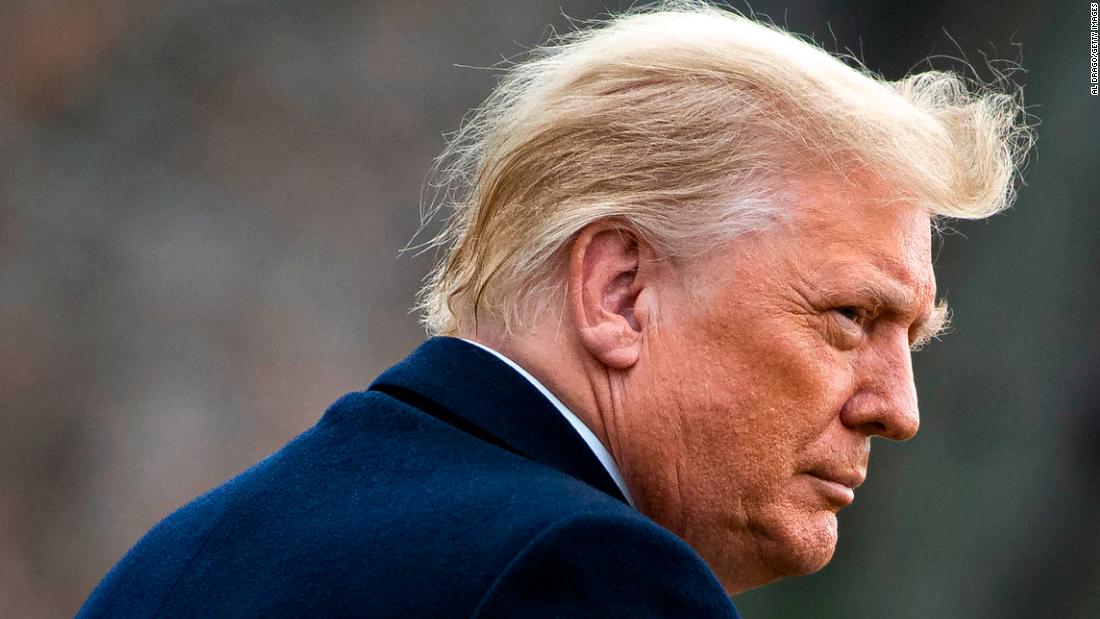Trump’s position may threaten to torpedo the carefully crafted bill, which his own government helped negotiate – a move that could lead to the government’s closure and screwing up the economy if he continued with a veto.
“I am asking Congress to amend this bill and raise the ridiculously low $ 600 to $ 2,000 or $ 4,000 per couple,” Trump said in a video posted on Twitter. “I am also asking Congress to immediately get rid of the useless and unnecessary items in this legislation or to send me an appropriate bill.”
The extraordinary message came after he left negotiations over the measure to lawmakers and his secretary of the Treasury, Steven Mnuchin. Trump did not explicitly threaten to veto the bill, but said he was dissatisfied with its final state.
“A few months ago, Congress started negotiations on a new package to get the urgently needed help for the American people. It took forever,” he said in the video.
“However, the bill that they are planning to send back to my table is very different than expected. It is really a shame.”
Still, Trump’s message seemed to be welcomed favorably by House Speaker Nancy Pelosi, who tweeted: “Republicans have repeatedly refused to say how much the president wanted for direct checks.”
“Finally, the president agreed to $ 2,000 – Democrats are ready to take this to the floor this week by unanimous consent,” she said. “Lets do this!”
Senate minority leader Chuck Schumer, however, tweeted: “We are happy to approve more aid that Americans need”, but emphasized that “Trump needs to sign the bill to help people and keep the government open” .
“Perhaps Trump can finally make himself useful and keep Republicans from blocking him again,” he said.
CNN contacted the offices of Senate majority leader Mitch McConnell and minority leader in the House, Kevin McCarthy.
Several sources told CNN that the president’s message will not lead to a renegotiation of the measure, which was approved with a large veto-proof majority.
At the moment, the hope of some on Capitol Hill is that Trump does not veto the bill, as he never explicitly said he would.
On Thursday, House Democrats will try to pass a bill to increase direct payments by unanimous consent, although either member can prevent this effort. It is not clear what will happen when or if such a bill is blocked.
Government funding ends next Monday.
Trump’s statement was filmed by the White House and was not open to the press. Reporters had no opportunity to ask the president questions. It is not clear when the message was recorded.
The president said in the past that he would sign the bill, and on Tuesday, the White House publicly defended the bill. But many of his allies have spoken out against the approved deal.
The White House did not respond to a request for comment.
The legislation includes direct payments of up to $ 600 per adult, increased unemployment benefits of $ 300 per week, about $ 284 billion in Salary Protection Program loans, $ 25 billion in rental assistance, an extension eviction moratorium and $ 82 billion for schools and colleges.
“We can finally report what our nation needs to hear for a long time: more aid is on the way,” Senate majority leader Mitch McConnell said on Sunday night when he announced the deal.
The agreement was closed only after both parties waived some of their main demands, with direct stimulus checks proving to be a major obstacle during negotiations.
Although Trump told people around him that he wanted direct payments to be much higher, he did not suggest that he was unwilling to accept the package containing the amount of $ 600 – half the amount of $ 1,200 approved in the first aid package, that some lawmakers had done pushing for this time.
When a deal was struck between Congressional leaders, Trump’s advisers signed on, believing the president was on board, although two officials said on Tuesday that they did not believe he had read the package in detail.
In fact, throughout his video message, Trump protested several provisions that were part of the general spending bill, not Covid’s aid bill.
“It’s called Covid’s relief bill, but it has almost nothing to do with Covid,” said the president at one point.
Although the general spending bill – which allocates money to all federal agencies for the rest of the fiscal year – was combined with the stimulus agreement, the funds allocated to the general bill do not mean that less is available for the bill of relief from Covid.
White House aides expressed surprise and annoyance at Trump’s video message on Tuesday.
Few advisers knew that the president was even recording the five-minute announcement of the Diplomatic Reception Room decorated with garlands in the basement of the residence, and at least one White House official, Assistant Press Secretary Brian Morgenstern, told reporters a hour before the video posted that Trump had signaled his intention to sign it.
After the video was posted, advisers struggled to find out what the president’s official position on the legislation was and whether he was really threatening to veto the legislation.
He was not directly involved in the negotiations, leaving the task to Mnuchin – who praised the package in a statement on Tuesday morning.
Like many of his own advisers, Republicans on Capitol Hill were not warned that Trump would protest the stimulus bill. An adviser to the Republican Party leadership said “no” to CNN when asked if this was expected.
This story has been updated.
Lauren Fox and Phil Mattingly of CNN contributed to this report.
